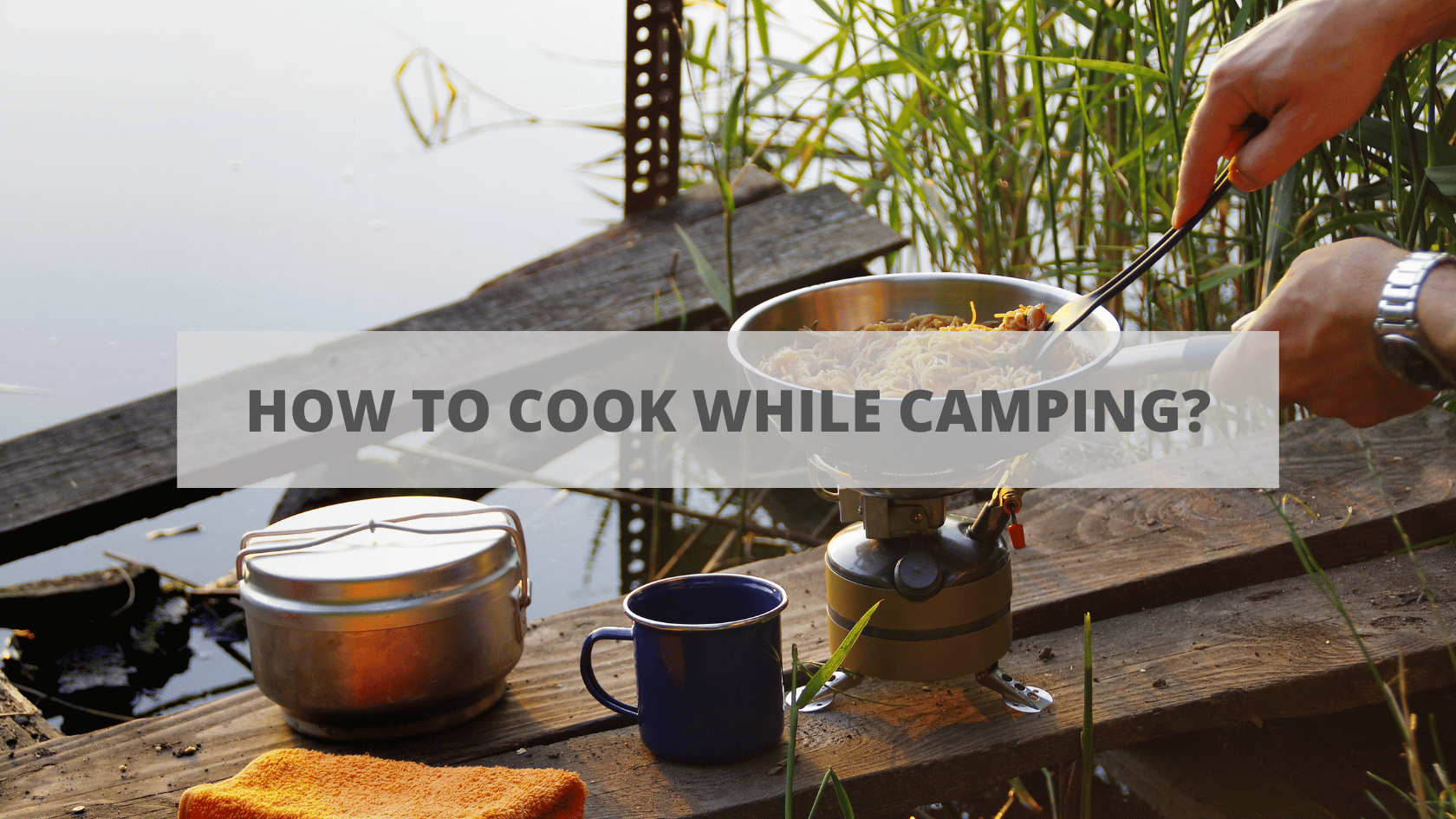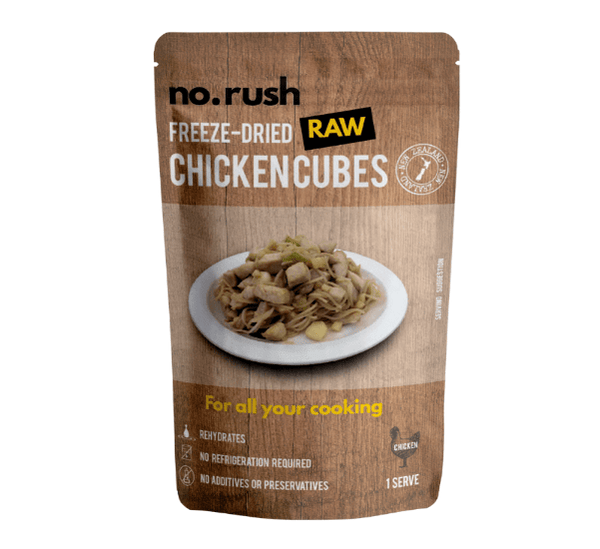- No products in the cart.

After a long day of hiking, fishing, exploring, and other outdoor activities, food tastes better outdoors. However, you do not have to limit yourself to burgers, canned chilli, and roasted hot dogs on a campsite. The challenge of cooking outdoors, away from your kitchen, is daunting for most people, but a little preparation and planning, along with a few tips and tricks, can make anyone a Camp Master Chef.
We should state more about how important it is to plan ahead of camping. You want to avoid being out in the wilderness and forgetting to bring something crucial like a lighter or some matches. Additionally, it is wise to have an alternative plan if the weather turns out to be different than what you expected. For example, if it is too wet to start a campfire and you only have raw meat, it is a good idea to have a propane stove and a tarp to protect it from the rain.
The Essentials for Cooking at Camping
You only need a little expensive gear to enjoy tasty meals at a campsite. Three essentials are all you need for camp cooking:Utensils and Cookware
Depending on the type of camping you will do, you will need different cookware. Bring heavy, cast-iron cookware if your car is parked close to the campsite. This trio covers all your cooking needs in combination with a pie iron and a dutch oven. Cookware and utensils are also necessary. We highly recommend that you purchase separate camping kitchen utensils set.
It is best to avoid rummaging through your camping cooking equipment and kitchen drawers just before a trip, as this is the easiest way to remember something. Tongs, spatula, ladle, wooden spoons, can and bottle openers, flat metal skewers, box grater, and cutting board are a few things to consider.
Stoves, Grills, and Fire Pit
Cooking requires heating, and fire provides heat outdoors. Camping is a traditional way to cook over a wood fire, but it requires some caution. The details of building a campfire will be discussed elsewhere in our blog, but make sure that flame suits your meal. For example, to make a stew, you need a small blaze, while to boil quickly, you need a large fire. Laying the best camping cookware on the hot coal should suffice if you intend to broil or fry.
You can control the flame more efficiently on a stove or grill than on an open fire. You can also light it up much easier, but remember to pack matches. You do not even need cookware to grill on a propane grill.
Drinks and Foods
Whether you are car camping or backpacking will determine what food you bring. Dehydrated food is the easiest option by far, and it is surprisingly tasty. The food you can eat outdoors is limitless if you are close to your vehicle. Just keep your fresh and perishable items cool when bringing food. For extended camping trips, canned food is handy for providing flavour and variety to your meals. Marinating or freezing meats can also extend their shelf life.
It will be helpful if you have plenty of water to keep everyone hydrated regarding drinks. Remember, though, that ice melts quickly, and since you probably will not be able to bring along your nugget ice machine, only expect to have ice-cold cocktails every day when you are car camping. Especially in cooler weather, tea, coffee, and hot chocolate are great options. You can also buy aluminium camping cookware for these hot chocolates and coffees.
The Cooking Methods
Generally, you think of camping cookware as roasting foods over an open fire. However, there are plenty of ways to prepare delicious meals at your campsite, even if it requires advanced cooking skills:Camp Stoves and Grills
There are plenty of excellent propane stoves and gas grills, from lightweight backpacking stoves to compact camp grills. There is no superior choice; select the one that works for you.
Using something other than stoves in enclosed spaces, like tents, will be the best option. It will help if you only use propane stoves outside, away from campfires and other heat sources. You can also use a pot or a pan on a camping cooking set stove. You can boil pasta, make stews and soups, and fry anything in an iron skillet. If you use smaller pots and pans and have fewer people to feed, a small camping stove may be just right if you stick with smaller pots and pans. A double-burner stove has room for a large frying pan and a small saucepan.
Charcoal Fire and Wood
Choosing the right type of wood for cooking over a fire is essential. Hardwoods like white oak, hickory, or cherry are long-lasting and burn for a long time. You can boil food over an open fire, but you will need the right kind of dish to cook it in. There are several options for cooking food over an open fire. First, you can boil it, and then you need a suitable dish.
It is best to fry food when the camping fire is nearly down to embers. Grilling is the most delicious way to cook food over a fire. It does not matter whether it is charcoal or wood; the important thing is that the heat is even smokeless.
It is essential to start the fire at least an hour before cooking to allow the flames to die and the coals to get hot. Also, remember that cooking on a campfire takes longer than cooking in the kitchen.
Dutch Oven
Sauté, steam, boil, fry, or bake - if you imagine it, you can probably cook it in a dutch oven. It can be used as a pot, a skillet, or an oven, as its name implies. You can use charcoal or wood embers in a dutch oven, but you can also use it elevated over a live fire.
Camping is a fantastic way to spend time outdoors with friends. However, preparing and cooking meals can be a challenging task. If there is no way to access a kitchen or grocery store, you must plan and ensure you have all the ingredients necessary for your meals at camp. Preparing the food at home can be more time-consuming, but it will also ensure that everything you need is waiting for you when you get there. Pack the appropriate camping cooking gear in your car or backpack, such as a stove, pots and pans, utensils, and ingredients. Getting ready for an adventure is all part of having a great camping experience!
What to cook on Your Camping Trip?
So, what can you cook on your camping trip? First, check these food products that suit you best when you go on camping:No Rush Freeze Dried Beef Slices 60g

Image From: No Rush Freeze Dried Beef Slices 60g
No Rush Freeze-Dried Beef Slices are the perfect addition if you want an extra beefy bite to your instant noodles. Make your next bowl of instant noodles a culinary experience with these ingredients. Add fish balls, crab sticks, vegetable condiments, and even crack an egg to this dish. If you want extra protein, add freeze-dried beef slices, too – they will transform it into something special.
No Rush Freeze Dried Chicken Cubes 30g

Image From: No Rush Freeze Dried Chicken Cubes 30g
No Rush Freeze-Dried Chicken Cubes are the perfect addition if you want extra protein to your outdoor cooking. Easy & convenient: Freeze Dried Chicken Australia allows hassle-free fast cooking for urban go-getters who want to cook healthy, convenient meals. You can use No Rush raw chicken cubes straight from your pantry or larder; no need to defrost or portion further.
If you enjoy long days in nature, you can now easily transport ultralight raw chicken around. Imagine biting into pieces of chicken while enjoying an old fire and some peace at the end of a long day.
No Rush Freeze Dried Beef Cubes 30g

Image From: No Rush Freeze Dried Beef Cubes 30g
Perfect for outdoor parties and BBQs - your chilly bin now has more space for drinks. As the product is 100% natural raw New Zealand beef, No Rush freeze-dried beef cubes are a healthy alternative to other preserved meat products. For the best texture, rehydrate them in water for 15-20 minutes. You can then add them to any stew or pasta sauce, and they will quickly rehydrate, absorbing the flavour.
No Rush Freeze Dried Beef Cubes 60g

Image From: No Rush Freeze Dried Beef Cubes 60g
Cooking at home or outdoors has always been challenging with this product. At room temperature, you do not need to refrigerate. Instead, you can cook raw beef for 15-20 minutes after rehydrating it with water. A portable source of protein that weighs only 60 grams per pack. It comes in convenient resealable pouches and is sufficient for two servings, depending on your appetite. By freezing freeze-dried beef in Australia and then drying it at a low temperature, freeze-drying preserves the product's properties and nutrients. Unlike dehydration, manufacturers fully cooked freeze-drying.








